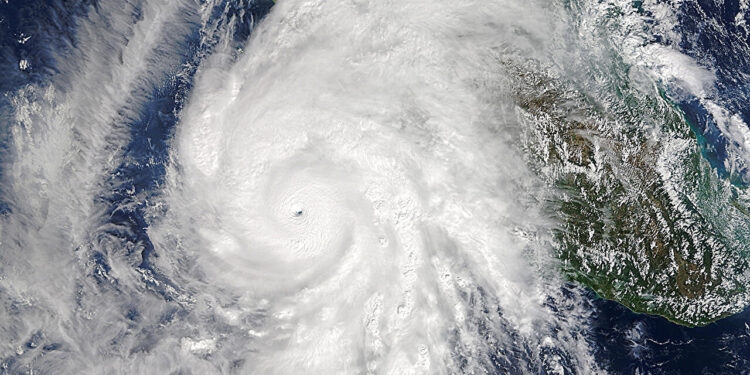Hurricane Patricia over the eastern Pacific Ocean. Credit: NASA
For more than 50 years, the National Hurricane Center has used the Saffir-Simpson Windscale to communicate the risk of property damage; It designates a hurricane on a scale from Category 1 (wind speeds between 74 and 95 mph) to Category 5 (wind speeds of 158 mph or greater).
But as rising ocean temperatures contribute to ever more intense and destructive hurricanes, climate scientists Michael Wehner of the Lawrence Berkeley National Laboratory (Berkeley Lab) and James Kossin of the First Street Foundation wondered whether Category 5 would last indeterminate was sufficient to communicate the risk of hurricanes. damage caused by hurricanes in a warming climate.
So, they investigated and detailed their in-depth research in a new article published in the Proceedings of the National Academy of Sciences (PNAS), where they also introduce a hypothetical category 6 on the Saffir-Simpson wind scale, which would encompass storms with wind speeds greater than 192 mph.
“Our motivation is to reconsider how the open nature of the Saffir-Simpson scale can lead to an underestimation of risk and, in particular, how this underestimation becomes increasingly problematic in a warming world,” said Wehner, who has spent his career studying how extreme weather events behave in a changing climate and the extent to which human influence has contributed to individual events.
According to Wehner, anthropogenic global warming has significantly increased ocean surface and tropospheric air temperatures in regions where hurricanes, tropical cyclones and typhoons form and spread, providing additional thermal energy for the intensification of storms.
When the team conducted an analysis of historical hurricane data from 1980 to 2021, they found five storms that would have been classified as Category 6, and all of them occurred in the last nine years of records. They determined a hypothetical upper limit for Category 5 hurricanes by looking at the increasing range of wind speeds between lower category storms.
Hurricanes, tropical storms, and typhoons are essentially the same weather phenomenon; their difference in name is purely geographical: storms in the North Atlantic and Northeast Pacific oceans are called hurricanes, events in the Northwest Pacific Ocean are called typhoons, and events in the South Pacific and Indian oceans are called cyclones tropical.
In addition to studying the past, the researchers analyzed simulations to explore the impact of global warming on the intensification of hurricanes. Their models showed that with global warming of 2 degrees Celsius above pre-industrial levels, the risk of Category 6 storms increases by up to 50% near the Philippines and doubles in the Gulf of Mexico and that the highest risk of these storms is located in the southeast. Asia, Philippines and Gulf of Mexico.
“Even under the relatively low global warming targets of the Paris Agreement, which aims to limit global warming to just 1.5°C above pre-industrial temperatures by the end of this century, the risks Increased Category 6 storms are substantial in these simulations,” Wehner said.
“Messaging about tropical cyclone risks is a very active topic, and changes in messaging are needed to better inform the public about inland flooding and storm surges, phenomena for which a wind-based scale has not been effective. only tangential relevance. While adding a 6th category to the Saffir “The Hurricane Simpson wind scale would not solve this problem, it could raise awareness of the dangers of increased risk of major hurricanes due to global warming,” Kossin said.
“Our results are not intended to propose changes on this scale, but rather to raise awareness that wind risk from storms currently designated as Category 5 has increased and will continue to increase under climate change.”
More information:
Wehner, Michael F. et al, The Growing Insufficiency of an Open Saffir-Simpson Hurricane Wind Scale in a Warming World, Proceedings of the National Academy of Sciences (2024). DOI: 10.1073/pnas.2308901121
Provided by Lawrence Berkeley National Laboratory
Quote: In a warming world, climatologists consider Category 6 hurricanes (February 5, 2024) retrieved February 5, 2024 from
This document is subject to copyright. Except for fair use for private study or research purposes, no part may be reproduced without written permission. The content is provided for information only.



